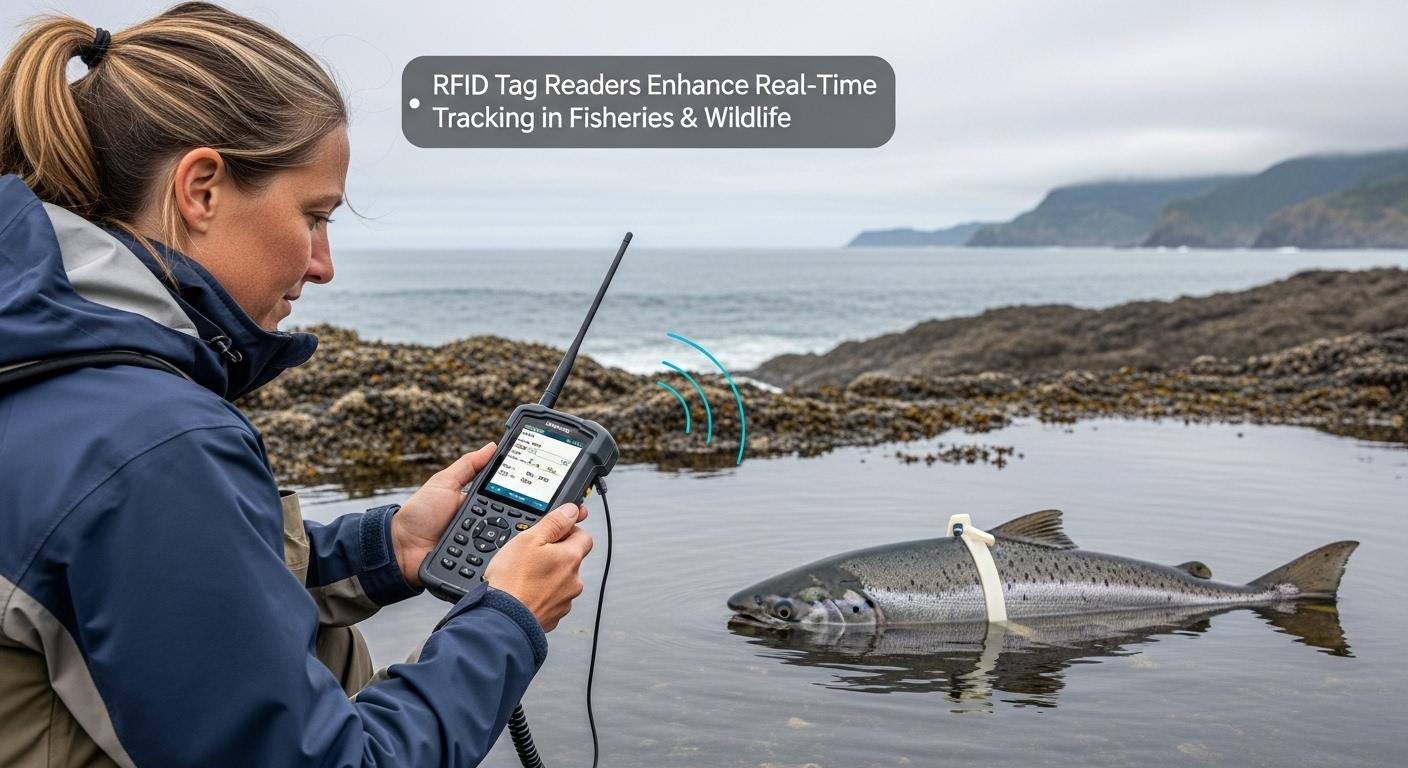How RFID Tag Readers Enhance Real-Time Tracking in Fisheries & Wildlife

The ability to monitor animal movements and behaviors as they occur, rather than reconstructing events retrospectively, represents a transformative advancement in ecological research and conservation management. RFID tag readers have emerged as the cornerstone technology enabling this real-time tracking paradigm, bridging the gap between traditional mark-recapture methods and the immediate data access demands of modern adaptive management. By converting passive identification systems into active monitoring networks, these detection platforms provide unprecedented temporal resolution, continuous surveillance capabilities, and instantaneous data availability that fundamentally reshapes how researchers approach population dynamics, behavioral ecology, and conservation decision-making in both aquatic and terrestrial ecosystems.
The Real-Time Advantage in Ecological Research
Traditional wildlife monitoring relied on periodic surveys and scheduled sampling sessions that provided snapshots of population status at discrete intervals. While valuable, these approaches missed dynamic processes occurring between observation periods and introduced substantial delays between data collection and analysis. Real-time tracking via RFID systems eliminates these limitations by providing continuous monitoring and immediate data access.
The temporal resolution achievable through automated RFID tag reader deployments captures behavioral dynamics invisible to conventional methods. Fish passage timing studies exemplify this capability—traditional visual counts during daylight hours documented daytime migration patterns while missing nocturnal movements that automated systems revealed comprised 40-60% of total passage. Research on steelhead migration through California's Central Valley discovered that peak movement occurred during 2-5 AM hours when manual observers were absent, fundamentally revising understanding of migration behavior and informing facility operation schedules.
Event-triggered monitoring enables rapid response to emerging situations. When RFID systems detect unexpected patterns—sudden cessation of normal movements, unusual aggregations, or absence of expected individuals—researchers receive immediate alerts enabling investigative action while events are still unfolding. A salmon monitoring program detected abnormal swimming behavior through erratic detection patterns at sequential antenna arrays, prompting immediate water quality investigation that identified an upstream pollution event requiring emergency response. Without real-time awareness, the incident would have gone undetected until scheduled weekly site visits.
Automated Continuous Monitoring Infrastructure
Fixed-station RFID tag reader installations create automated surveillance networks that operate continuously without human presence, dramatically expanding monitoring capacity while reducing labor costs. These systems transform single-point observations into comprehensive coverage spanning entire study areas, rivers systems, or migration corridors.
Strategic antenna placement at key chokepoints—fish ladders, stream confluences, migration bottlenecks, or territorial boundaries—enables population-wide monitoring. The Columbia River basin maintains over 100 fixed RFID detection sites creating a surveillance network spanning 1,200 kilometers. Individual salmon tagged in headwater tributaries generate detection histories documenting entire life cycles from juvenile outmigration through adult return migrations, creating datasets impossible through manual sampling approaches.
Multi-antenna arrays at individual sites add spatial resolution revealing fine-scale movement patterns within monitored locations. Research examining spawning habitat selection deployed six-antenna grids spanning 50-meter reaches, documenting that female Chinook salmon showed strong preferences for specific 5-meter sections based on substrate characteristics and water velocity patterns. This micro-scale habitat use information guides restoration efforts, ensuring limited conservation funding targets interventions at spatial scales matching biological requirements.
Detection redundancy through overlapping antenna coverage ensures data completeness. Critical monitoring sites employ multiple independent RFID tag readers and antenna arrays creating fail-safe systems where equipment malfunctions don't produce data gaps. Comparison studies found that redundant systems captured 99.8% of tagged individuals compared to 94-96% for single-antenna installations, with the difference proving statistically significant for population abundance estimation accuracy.
Immediate Data Access and Cloud Integration
Modern RFID systems increasingly incorporate connectivity enabling real-time data transmission to centralized databases accessible from anywhere with internet access. This immediate availability transforms data from retrospective records into actionable intelligence supporting dynamic management decisions.
Cellular-equipped tag readers upload detection events to cloud servers within minutes of occurrence, creating live dashboards displaying current system status, recent detections, and analytical summaries. Fisheries managers monitoring salmon runs access web portals showing passage counts updated hourly, enabling harvest quota adjustments responding to actual migration timing rather than historical predictions. During the 2023 season, Columbia River managers increased commercial fishing opportunities by 15% based on real-time data indicating stronger-than-predicted returns, optimizing economic benefits while maintaining conservation goals.
Application programming interfaces (APIs) enable custom integrations connecting RFID data streams to other monitoring systems, environmental sensors, and management databases. A comprehensive watershed monitoring program integrated RFID tag reader data with weather stations, stream gauges, and water quality sensors, creating unified databases contextualizing animal movements within environmental conditions. Machine learning models analyzing these integrated datasets predict migration timing with 92% accuracy three days in advance, allowing proactive management preparations.
Mobile applications bring real-time data to field personnel's smartphones, eliminating delays between field observations and data access. Biologists conducting stream surveys query centralized databases confirming whether encountered fish are tagged individuals, retrieving complete detection histories informing on-site decisions about recapture protocols or health assessments. This immediate context prevents unnecessary handling of recently processed individuals while ensuring adequate sampling of underrepresented demographic groups.
Behavioral Studies with High Temporal Resolution
Understanding animal behavior requires observations at temporal scales matching behavioral processes. Real-time RFID tracking achieves resolution from seconds to years, capturing rapid responses and long-term patterns within unified datasets.
Diel activity patterns emerge clearly from continuous monitoring. Studies employing RFID tag readers discovered that brook trout exhibited distinct activity rhythms with peak movements during crepuscular periods—dawn and dusk hours comprising only 15% of daily time but accounting for 60% of observed movements. This finding revealed that traditional daytime observation methods systematically underestimated activity levels, providing incomplete behavioral understanding. Management implications include recognizing that disturbance during crepuscular periods has disproportionate impacts on critical foraging and social behaviors.
Reproductive behavior monitoring through strategically positioned antennas reveals spawning site fidelity and temporal patterns. Research on smallmouth bass employed RFID arrays around known spawning locations, documenting that males arrived 5-7 days before females and defended nesting territories averaging 15 square meters. Real-time detection data revealed that territory tenure lasted 12-16 days post-spawning as males guarded developing eggs, information previously requiring intensive visual observation now obtained automatically through electronic monitoring.
Social interactions and dominance hierarchies become quantifiable through detection patterns at resources like feeding stations or shelter sites. Studies of territorial salmonids placed RFID antennas around preferred habitat features, recording visit frequencies and durations revealing dominance relationships. Dominant individuals visited prime locations 3-4 times more frequently than subordinates and maintained 60% longer residence times, demonstrating resource monopolization quantified through automated tracking that would prove impossible via direct observation of cryptic fish in complex habitats.
Migration Timing and Environmental Triggers
Understanding how environmental conditions influence migration timing requires correlating animal movements with continuously monitored environmental variables. Real-time RFID tag reader systems integrated with weather stations and hydrological sensors reveal these relationships with precision impossible through periodic sampling.
Temperature-driven migration thresholds emerge from analyses correlating detection timing with water temperature. Research on Pacific salmon found that upstream migration initiation occurred reliably when water temperatures reached 12-14°C, with migration intensity peaking at 16-18°C and declining sharply above 20°C. These quantitative relationships inform predictions of climate change impacts and guide management actions like temporary fishery closures protecting thermally stressed populations during extreme heat events.
Flow regime influences appear clearly in real-time data. Anadromous fish migrations often synchronize with freshet events—increased flows from rainfall or snowmelt. Studies employing continuous monitoring documented that 70-80% of migration occurred during flow pulses comprising only 20-30% of total season duration. This concentrated movement pattern indicates that maintaining natural flow variability in regulated rivers becomes critical for facilitating passage, informing dam operation schedules that balance hydropower generation with ecological requirements.
Lunar phase correlations revealed through continuous monitoring surprise researchers accustomed to focusing on water conditions alone. Several studies discovered that nocturnal migrations peaked during new moon periods when darkness was most complete, suggesting predation risk avoidance strategies. These findings were only detectable through continuous monitoring capturing complete lunar cycles rather than opportunistic sampling missing critical periods.
Population Dynamics and Survival Estimation
Real-time detection data revolutionizes population parameter estimation by providing comprehensive encounter histories across entire study periods rather than discrete sampling occasions. This completeness improves statistical precision while reducing assumptions inherent in traditional mark-recapture analyses.
Survival rate estimation achieves unprecedented accuracy through continuous monitoring. Traditional approaches requiring multiple discrete sampling occasions suffer from violation of closure assumptions—population changes between samples introduce bias. Real-time systems essentially create continuous sampling across entire study periods, eliminating closure issues and dramatically improving survival estimate precision. Studies comparing methodologies found that RFID-based survival estimates had confidence intervals 40-60% narrower than traditional approaches, enabling detection of subtle treatment effects or population trends requiring larger sample sizes with conventional methods.
Migration success and reach-specific survival become quantifiable through sequential detection stations. Research monitoring salmon passage through multi-dam river systems employed RFID tag readers at each facility, calculating survival between consecutive dams. These reach-specific estimates identified mortality hotspots—one dam reach showed 88% survival versus 96% at adjacent reaches—directing management attention and infrastructure improvements to problematic locations. Without real-time continuous monitoring, these spatial patterns would remain obscured in coarse survival estimates spanning entire river systems.
Adaptive Management Applications
The defining advantage of real-time RFID tracking lies in enabling adaptive management—adjusting conservation actions based on current conditions rather than historical patterns or scheduled interventions. This responsiveness maximizes conservation effectiveness while accommodating uncertainty inherent in ecological systems.
Harvest management benefits enormously from real-time abundance monitoring. Fisheries employing RFID tag readers at river entrances track run strength as migrations develop, comparing actual returns against pre-season forecasts. When runs exceed predictions, managers incrementally expand fishing opportunities capturing economic benefits of abundant years. Conversely, weaker-than-expected returns trigger immediate harvest restrictions protecting depleted populations. The Columbia River salmon fishery adjusts commercial and recreational quotas up to five times during migration seasons based on real-time monitoring, optimizing sustainable harvest in a way impossible under rigid pre-season quota systems.
Hatchery operations adapt release timing and locations based on real-time environmental monitoring. When RFID systems indicate poor migration success under current conditions—low flows, high temperatures, or predator concentrations—hatcheries delay releases until conditions improve. Studies found that adaptive release timing increased juvenile survival by 20-35% compared to fixed release schedules, substantially improving hatchery program effectiveness.
Predator management employs real-time detection data identifying consumption hotspots. Research integrating RFID tag reader data with predator monitoring documented that pinnipeds concentrated at specific dam tailraces during salmon runs, consuming up to 25% of returning adults. Real-time awareness enabled dynamic hazing efforts concentrating on highest-impact periods and locations, reducing predation to 12% through targeted interventions informed by continuous monitoring.
Research Cost Efficiency and Data Multipliers
While fixed tag reader infrastructure requires substantial initial investment, the continuous data generation creates remarkable cost efficiency compared to labor-intensive manual surveys. A single detection station operates 24/7 for years, generating hundreds of thousands of observations that would require impossible amounts of field personnel time through traditional methods.
Economic analyses comparing monitoring approaches found that RFID systems achieve cost per detection 85-95% lower than manual sampling after accounting for equipment amortization over multi-year study periods. A five-year monitoring program requiring 10,000 observations annually costs approximately $150,000 using manual surveys ($15/observation) versus $25,000 for equivalent RFID coverage including initial infrastructure investment and annual maintenance. These dramatic efficiencies enable long-term monitoring programs essential for detecting gradual population trends or climate change impacts that require decadal datasets.
Conclusion
RFID tag readers have fundamentally transformed wildlife and fisheries research by enabling real-time tracking that provides immediate data access, continuous monitoring, and temporal resolution capturing dynamic ecological processes as they unfold. From revealing nocturnal behaviors invisible to traditional observation to enabling adaptive management responding to current conditions, these systems deliver research capabilities that dramatically advance conservation science. The integration of detection networks with environmental sensors, cloud computing, and mobile technologies creates comprehensive monitoring frameworks supporting evidence-based decision making at temporal scales matching ecological dynamics. As technology continues advancing and costs decline, real-time RFID tracking will increasingly become standard practice, strengthening our collective capacity to understand and protect wildlife populations facing mounting pressures from habitat loss, climate change, and human activities.






